A Scion Society of The Baker Street Irregulars
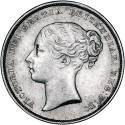
Here Are Your Wages (1971)
“Here are your wages.”
– A Study In Scarlet (STUD)
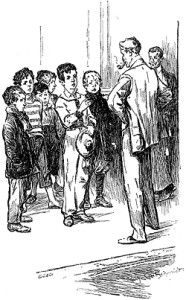
Sherlock Holmes handed each of the original Baker Street Irregulars a shilling and said, “Here are your wages.” As you know, today’s Irregulars have as a symbol the Victorian shilling.
This, more than any other, is the coin we associate with Holmes. Though the Canon mentions other British (and a few foreign) coins, the shilling is the one (immediately brought to mind).
A Study in Scarlet introduced “the Baker Street division of the detective police force. ” It also provided the famed “wages” quote. In The Sign of Four, the Master once more called on the Irregulars, at their usual shilling-per-day wage, in seeking the steam launch that Jonathan Small and Tonga meant to use as a getaway vehicle.
Usually we gloss over the shilling. We accept it as part of the cases’ Victorian background. But let us for once take a second look.
The coin is the size of our own quarter dollar. It was worth just about as much during the 1880s. The edge is reeded, like the edges of U. S. dimes, quarters and half-dollars of today. Modern shillings (and coins worth 5 new pence, which replace them) are cupro-nickel, but the shillings issued while the Master was active were silver.
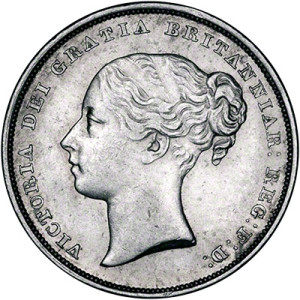
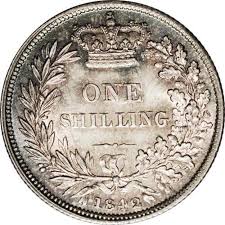
The obverse of a typical shilling used by Sherlock Holmes featured a “Young Head” portrait of Queen Victoria.
Queen Victoria’s “Young Head” type shillings were issued with only minor portrait changes from 1838 (the year after her reign began) through 1887. On the obverse of the typical shilling used by Sherlock Holmes we find the young queen’s left-facing portrait, wearing a double hair-ribbon at the front of her head and with most of her hair gathered at the back in a loose bun or small pony-tail. This portrait was drawn by William Wyon, one of England’s great coin designers.
Around the obverse rim, just inside the beaded outer rim, is VICTORIA DEI GRATIA BRITANNIAR: REG: F: D. This Latin inscription is the last vestige of the old “divine right of kings, ” for it is translated “Victoria, by the Grace of God, Queen of all the Britains, Defender of the Faith. ”
The reverse was drawn by J. B. Merlen for the shillings of William IV. It simply was continued on Victorian shillings. This has a wreath around the rim; a small open space at the wreath’s top is filled by an ornate imperial crown. ONE is above SHILLING in the center. At bottom, below the wreath, is the date in tiny numerals.
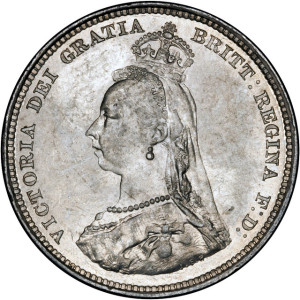
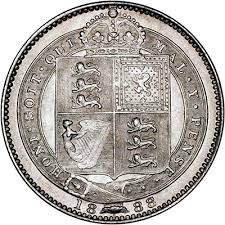
Shillings issued between 1887 and 1892 depicted a new portrait of the queen in honor of her Golden Jubilee.
Some Victorian shillings, especially those issued in the 1864-79 period, have an additional number above the date. This is a die identification, and it appears on some other denominations, too.
Collectors are used to finding one feature that I’ ve omitted from this description: national identification. It isn’t on the coin at all. Rule Britannia! England was England, and the world was expected to be able to recognize coins issued by that land on whose domains the sun never set.
In 1887 a new design appeared; this is the “Jubilee Head” type, issued only [from] 1887-92, . It shows an older portrait wearing a small crown; the portrait was enlarged in 1889. The old reverse gave way to a new coat-of-arms design by Sir J. Boehm.
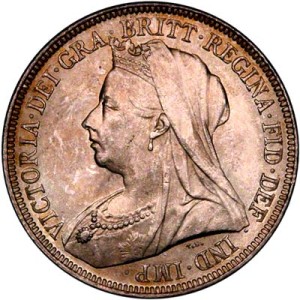
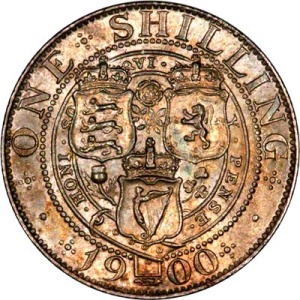
As Queen Victoria aged, so did her portrait on British coinage. This “Veiled Head” shilling depicts a more somber, mature queen.
The “Old Head, ” more often called the “Veiled Head, ” shows a heavy, aged portrait [of the queen] in a low crown, from [which] a veil descends to cover the queen’s hair and part of her neck and shoulders. The design is by Sir Thomas Brock. A new reverse drawn by Sir Edward Paynter features three shields within the Garter.
Many shillings remained in use for many years, so we may safely deduce that most of the shillings handled, paid out, or received in daily life by the Master were “Young Head” type coins.
The shilling is absent from the narratives of most cases, but it reappears in The Hound of the Baskervilles. You will recall that the boy who searched through the waste paper of 21 hotels for the newspaper from which Beryl “Stapleton” cut her warning message paid his way with shillings.
Those who have earned the honor already own one of these coins — but can non-investitured Irregulars do so? They not only can, but probably do — if they happen to be numismatists. Almost every coin collector who owns British coins has a shilling among them.
For non-collectors, there are two easy ways to obtain one of these Sherlockian coins. One is to visit the nearest coin store; the other is to read advertisements in one of the hobby’s papers or magazines, find a dealer whose ad offers British shillings, and order one by mail.
Despite their age, Victorian shillings cost very little. Demand for Young Head ones remained low for a long time; dates with mintage of four million or more cost only about $1 in Good condition and $3 to $4 in Fine. I would recommend that you buy the highest condition you can, so as to see as much detail as possible.
Many Victorian shillings are rare, of course. In the early years, mintage often dropped below one million. The rarest date is 1851, with just 470, 071 minted; 1872 is the top-minted date, with 8, 897, 781 struck. All of these coins were struck at the Royal Mint in London.
In addition to the major design changes, there are a large number of sub-types created by minor design revision done to improve the coin’s appearance or to show the queen’s advancing age. But all the coins have three points in common: 1) they are well-designed and beautiful; 2) they feature a portrait of an August Lady; and 3) they form a part of the heritage of every coin collector — and every follower of the Master.
Reprinted by permission from the BAKER STREET JOURNAL, 21, No. 2 (June 1971), pages 77-79. Copyright 1971 by the Baker Street Irregulars.
 Norman M. Davis was an active Sherlockian in the Washington, DC and Chicago areas. In 1972, Davis was invested in the BSI as The Grosvenor Square Furniture Van. An active freelance writer, he had a syndicated newspaper column on coin collecting and was the author of The Complete Guide to United States Coin Collecting. Davis passed away in 2004.
Norman M. Davis was an active Sherlockian in the Washington, DC and Chicago areas. In 1972, Davis was invested in the BSI as The Grosvenor Square Furniture Van. An active freelance writer, he had a syndicated newspaper column on coin collecting and was the author of The Complete Guide to United States Coin Collecting. Davis passed away in 2004.

Sorry, comments are closed for this post.